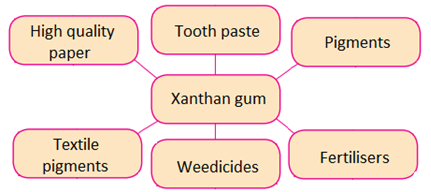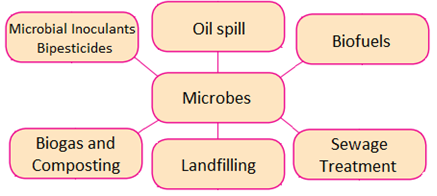Class 10 MAHARASHTRA STATE TEXTBOOK BUREAU Solutions Science Chapter 7 - Introduction to Microbiology
Introduction to Microbiology Exercise Exercise
Solution 1
a. Process of coagulation of milk proteins occurs due to lactic acid.
(Lactobacilli are the bacteria which bring about the fermentation of milk. In this process, the lactose sugar in milk is converted into lactic acid. This lactic acid causes coagulation of proteins present in the milk.)
b. Harmful bacteria like Clostridium in the intestine are destroyed due to probiotics.
(Probiotics contain Lactobacilli which are useful for the body. They control the growth and metabolism of other bacteria present in the alimentary canal. These bacteria thus stop the action of Clostridium which are harmful bacteria for the body.)
c. Chemically, vinegar is acetic acid.
(Chemically vinegar is 4% acetic acid. It is a good preservative of food and thus while using it as an additive for food, it is called vinegar.)
d. Salts which can be used as supplement of calcium and iron are obtained from gluconic acid.
(The microbe Aspergillus niger acts on the source material, glucose and corn steep liquor to produce amino acid called gluconic acid. Gluconic acid is used for the production of minerals which are used as supplements for calcium and iron.)
Solution 2

Solution 3.a
Fuels obtained by microbial processes:
- Microbial anaerobic decomposition of urban, agricultural and industrial waste forms a gaseous fuel in the form of methane gas.
- Alcohol is yet another clean form of energy which is used in the form of ethanol. It is obtained by the fermentation of molasses by the action of the yeast, Saccharomyces cerevisiae.
- The process of bio-photolysis of water results in photoreduction of water with the help of bacteria. This process releases hydrogen gas which is said to be the fuel of the future.
It is necessary to increase the use of such fuels because:
- Conventional fuels are exhaustible and will soon be completely over after few hundred years later. Moreover, burning of these fossil fuels causes a lot of air pollution.
- On the other hand, the fuels obtained by the microbial processes are non-polluting. Therefore, it is necessary to increase the use of such eco-friendly fuels.
Solution 3.b
- Oil spills in rivers or oceans are caused by crude oil or petroleum hydrocarbons.
- This crude oil is highly toxic to the flora and fauna of the aquatic environment.
- The oil spills can be removed by mechanical methods. However, this is a very tedious process.
- Biologically, the oil spills can be removed using a culture of microbes like Pseudomonas spp. and Alcanovorax borkumensis. These bacteria have the ability to destroy the pyridines and other chemicals present in the hydrocarbons.
- They are called hydrocarbono-clastic bacteria (HCB) as they decompose the hydrocarbons and bring about the reaction of carbon with oxygen. CO2 and water are formed in this process.
- In this way, oil spills of rivers and oceans are cleaned, by releasing HCB at the site of oil spills.
Solution 3.c
- The soil polluted by acid rain is made fertile again using bacteria.
- Bacteria such as Acidophillium spp. and Acidobacillus ferroxidens have the capacity to utilise sulphuric acid as their energy source.
- Sulphuric acid is present in acid rain which can thus be utilised by these bacteria.
- In this way, bacteria can control the soil pollution occurring due to acid rain, making the soil fertile again.
Solution 3.d
Importance of biopesticides in organic farming:
- Soil pollution can be minimized by using biopesticides.
- Use of chemical pesticides and fertilizers causes large scale soil pollution.
- When chemical pesticides are used in agriculture, there is contamination of soil by fluoroacetamide-like chemicals.
- These chemicals are harmful to plants, animals as well as human beings. They may even cause skin diseases in humans.
- The use of bacterial and fungal toxins destroys the pests and pathogens. Such toxins are directly incorporated in the plant materials. E.g. Spinosad is a biopesticide produced as a by-product of fermentation.
Solution 3.e
- Probiotic substances are mostly milk products containing live bacteria. Such probiotics are very good for health.
- Colonies of useful bacteria are produced in the alimentary canal of human beings due to probiotics.
- Probiotics decrease the population of harmful microbes like Clostridium from our digestive tract.
- Immunity is enhanced due to regular intake of probiotics in the diet.
- The ill-effects of harmful substances formed during metabolic activities are reduced by the use of probiotics.
- If someone in on antibiotic treatment, the useful intestinal bacterial flora become inactive or are eradicated from the body. In such cases, probiotics restore the bacterial flora and make the person healthy again.
Solution 3.f
- In order to make bread, baker's yeast - Saccharomyces cerevisiae is added to the flour for the fermentation process.
- Commercial bakery uses compressed yeast while dry, granular form of yeast is used in domestic settings.
- The flour prepared using commercial yeast contains various useful contents like carbohydrates, fats, proteins, various vitamins, and minerals.
- Anaerobic fermentation also increases the nutritive content of the flour. As a result, bread and other products produced with the help of yeast become nutritive.
Solution 3.g
Precautions necessary for proper decomposition of domestic waste:
- The domestic waste should be properly segregated into biodegradable (wet waste) and non-biodegradable (dry waste).
- After segregation, these wastes should be stored separately in two different containers.
- The biodegradable substances should be decomposed naturally. The decomposition process can even be done at the house-hold level, in a pot or a tank. The pot should be covered by a thin layer of soil and it should be kept in dark but airy place. This process yields a rich manure.
- The non-biodegradable substances should either be reused or sent for recycling.
- The non-biodegradable substances such as plastic articles, glass pieces, metal objects, unused medicines and e-waste should never be thrown in wet wastes. The toxic substances and the insecticides, if added to wet waste, will never allow the natural decomposition process.
- Therefore, only after taking proper precautions we can aim at proper decomposition of domestic wastes.
Solution 3.h
- Plastic is a non-biodegradable substance. It cannot be degraded by the action of microorganisms. It persists in the environment in its original form for several hundreds of years.
- Plastic causes solid waste pollution in the environment wherever it is thrown indiscriminately.
- If burnt, it releases very toxic gases.
- If dumped in landfills, it obstructs the other decomposition processes.
- If thrown in water bodies, it causes harm to the aquatic life.
- Cattle graze on plastic unknowingly and are killed as plastic clogs inside their alimentary canal.
- The gutters and rain water drains get clogged due to plastic bags and this causes cities to submerge in water during heavy rains.
- Now-a-days, instead of fishes, fishermen majorly get plastic if they cast their net in the sea.
- People use plastic bags indiscriminately without any thought towards their environmental impact. There are better alternatives for plastic bags such as cloth bags which can be reused again and again.
- Therefore, it is absolutely necessary to ban the use of plastic bag to save the environment.
Solution 4

Solution 5.a
- Industrial microbiology involves the commercial use of microbes.
- Such microbial experiments includes various economic, social and environment related processes and products.
- Fermentation processes are used to make bread, cheese, wines, enzymes and nutrients.
- Different types of antibiotics are also made using processes of industrial microbiology.
- Industrial microbiology becomes helpful in pollution control and solid waste management.
- In farming too biotechnology is used to produce Bt crops.
- Thus, use of mutant strains has been increased in industrial microbiology.
Solution 5.b
- When detergents are mixed with microbial enzymes, they start working more efficiently.
- The cleaning process takes place at lesser temperatures.
- Therefore, for better results, enzymes obtained by microbial process are mixed with detergents.
Solution 5.c
- Microbial enzymes are active at low temperature, pH and pressure.
- As a result, a lot of energy is saved and the use of costlier erosion-proof instruments can be avoided.
- In enzymatic reactions, unnecessary by-products are not formed as the reactions are highly specific.
- The expenses on purification of the product are minimized as no unnecessary products are formed.
- The elimination and decomposition of waste material is avoided and enzymes can be reused again.
- Hence, microbial enzymes which are eco-friendly are used in chemical industry.
Solution 6

Solution 7

Solution 8.a
Role of microbes in compost production:
- Microbes can bring about natural decomposition of the organic compounds.
- During biodegradation, certain bacteria and fungi bring about the decomposition process and release inorganic constituents back into the nature.
- In this way, compost is formed by the recycling process.
Solution 8.b
Benefits of mixing ethanol with petrol and diesel:
- Use of diesel or petrol as independent fuels results in increased air pollution.
- Moreover, as these fuels are non-renewable and exhaustible, they will soon be depleted in few years.
- When petrol and diesel are mixed with ethanol, the proportion of CO2, CO, and hydrocarbons emitted in the atmosphere becomes lesser.
- The particulate pollutants, which otherwise are emitted through combustion of petrol and diesel, are not formed when these fuels are mixed with ethanol.
- By adding ethanol to the fuels, the cost of expensive petrol or diesel also becomes less.
- Ethanol burns more efficiently, hence ethanol is mixed with petrol and diesel.
Solution 8.c
Ethanol is obtained from wheat, maize, beet, sugarcane and molasses of sugarcane.
Plants such as soybean, rapeseed, jatropa, mahua, flaxseed, mustard, sunflower, palm, jute and some types of algae are cultivated for the production of biodiesel.
Solution 8.d
Biogas and biodiesel are mainly obtained from biomass. Biogas is obtained from the dung of cattle. Fermentation of cattle dung produces methane which later produces methanol. Ethanol is obtained from molasses of sugarcane and some other crops. In some countries, special crops are cultivated for the production of biodiesel.
Solution 8.e
When the dough for bread is prepared, baker's yeast - Saccharomyces cerevisiae is added to it. The yeast carries out anaerobic fermentation which results in the formation of CO2 and ethanol. The CO2 formed tries to escape out of the flour which causes the dough to rise. When such dough is baked, it produces spongy bread.

